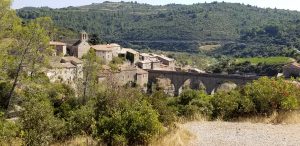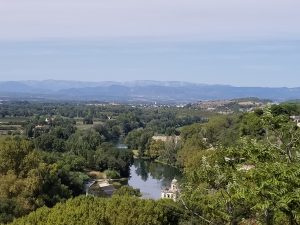We Americans like our driving to be easy. We like highways and when we go wine tasting, we like there to be a few main roads that take us to all the wineries. In Napa Valley it’s Route 29 and the Silverado Trail. In Sonoma County it’s Route 101. In some parts of Europe they feel the same way. The main roads are the D2 in the Médoc and the Route des Grands Crus in Burgundy’s Côte d’Or.
The Languedoc is much older than these regions, wilder, more spread out and frankly, poorer. Each appellation is somewhat self-contained covering a wide swath without much of a center point. The vineyards and wineries are often on small, single-lane roads quite removed from the major roads. These “major roads” are themselves two lanes wide and often twist through villages and turn around precipices.
The village of Minerve, for which the Minervois is named
Of course, you can use a GPS, as we did. We named the voice of our guide Fifi and in fairness she always seemed to know the shortest route. But the shortest is often (in fact, usually) not the best and we spent way too much time in a car that was narrower by two inches on either side than the paved road, following a tractor that was going ten miles an hour. Passing was out of the question.
So if you’re going to go wine tasting in the Languedoc – and we hope you do – here are a few tips for getting around.
- Don’t just rely on Fifi. Check out the roads on the Internet before you set out. If Google Maps says you should go the D11 to the D612 to the D909 and Fifi tries to take you on some tiny road, ignore her. If despite that you do get lost, she can bail you out…eventually.
- Get a good map. Presumably, the French know where they’re going but you don’t. So when you’re driving, say, to the Minervois, you want to go in the direction of Narbonne, until you don’t. The map will let you pick off the names of towns and villages that are along your route so you can tell the difference between making headway and getting lost. Particularly in the Languedoc, the names of towns can be confusing. Murveil-les-Beziers is not the same place as Beziers, nor is Cazouls-les-Beziers. You’ll get to Poilhes before you can learn to pronounce it.
The view from the walls of Beziers
- Watch the signs closely. The French are quite good at marking their roads. If you keep a sharp eye, you’ll see the major destination on a green field at the top of road signs with several of the next villages listed below. In the major winemaking areas, you will see signs pointing to châteaux and domaines with just barely enough time to take the indicated exit. Then just keep going; eventually there will be another sign telling you where the winery is.
This sort of advice is useful in the Languedoc, but it’s also applicable in other less traveled areas of Wine Country. So if you blunder about a bit, don’t worry. Just enjoy the scenery. You will get somewhere, if not always where you expected to go.

